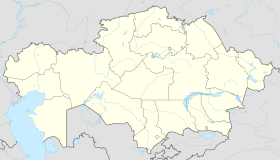
Back Атрарская катастрофа Byelorussian Sitio de Otrar Spanish Pengepungan Otrar ID Отырар апаты Kazakh ஒற்றார் முற்றுகை Tamil Otrar Faciası Turkish Oʻtror mudofaasi Uzbek
| Otrar Catastrophe | |||||||
|---|---|---|---|---|---|---|---|
| Part of the Mongol conquest of the Khwarazmian Empire | |||||||
 The remnants of the citadel at Otrar, which was comprehensively destroyed by the Mongols. | |||||||
| |||||||
| Belligerents | |||||||
| Mongol Empire | Khwarazmian Empire | ||||||
| Commanders and leaders | |||||||
| |||||||
| Units involved | |||||||
| City garrison | ||||||
| Strength | |||||||
| 50,000-75,000 | 5,000-15,000 | ||||||
| Casualties and losses | |||||||
| Minimal | Huge | ||||||
Location of the siege on a map of modern Kazakhstan | |||||||
The Otrar Catastrophe was a siege that took place between December 1219 and February 1220 during the Mongol conquest of the Khwarazmian Empire at Otrar, a large trading city on the Syr Darya river. Inalchuq, the city's governor, had seized the goods of a Mongol trade caravan the previous year; after more provocations from Inalchuq's liege and ruler of the Khwarazmian Empire, Shah Muhammad II, Genghis Khan launched a full-scale invasion of the empire.
The city had been extensively garrisoned and fortified, and the Mongol troops found it difficult to breach the battlements. Progress was slowly made, and by February Genghis felt confident enough to detach part of his army and head southwards towards Transoxiana. His sons Chagatai and Ogedai were left behind to continue the siege. Qaracha, the leading general of the city, deserted in February 1220 and the inner citadel fell soon afterwards. Inalchuq was captured alive, and was executed. Some sources relate that he was executed by having molten metal poured into his orifices; this story, symbolising his greed in seizing the caravans, is almost certainly apocryphal.
Muhammad had expected the nomadic invaders to fail in capturing Otrar. Its seizure left the Khwarazmian heartland open to conquest—the Mongols would isolate and capture the great cities of Bukhara, Samarkand, and Gurganj in turn. The Otrar oasis would revive as the Syr Darya shifted in its course; the Khwarazmian citadel would remain abandoned.
